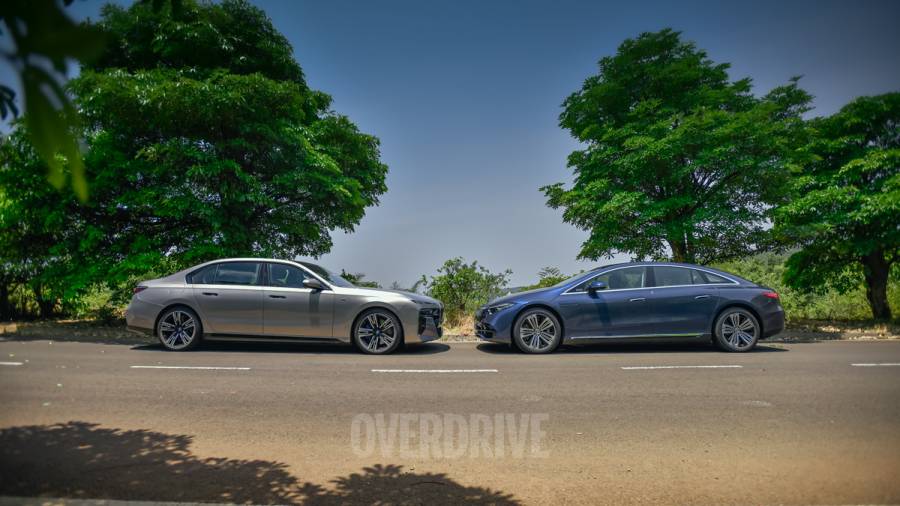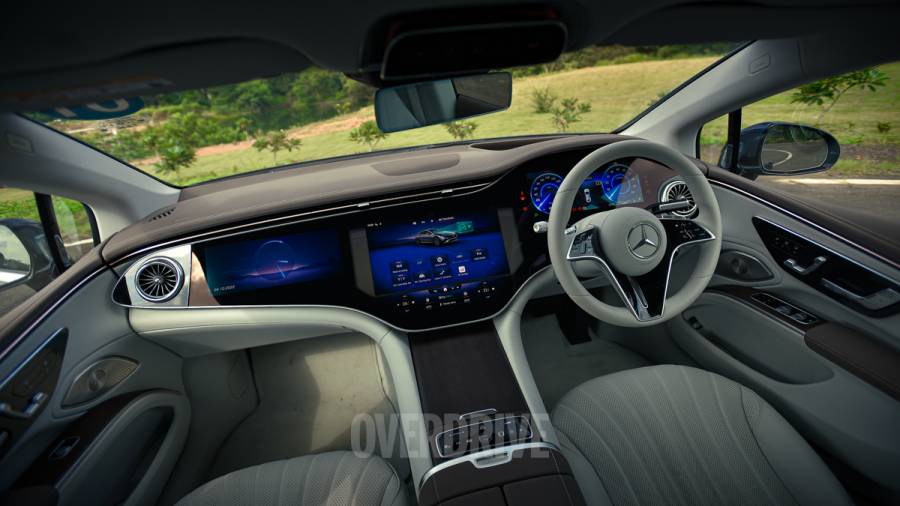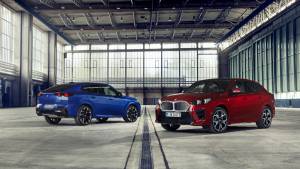Split the difference: BMW i7 and Mercedes EQS
You know EVs to be affordable to run, easy on the Earth, and sometimes not as easy to live with. But when you are in the world of luxury mobility, an EV powertrain suddenly makes sense. The silence, and the smooth uninterrupted power delivery, fit right in with the experience of a soothing luxury car. The Mercedes EQS and the BMW i7 are at the top of the food chain in this regard for their brands, but it runs a bit deeper than that.
BMW i7 and Mercedes EQS: styling
Look at the i7 and EQS and it's clear that BMW and Mercedes-Benz have quite divergent ideas of where their cars should go in the electric era. The BMW i7's presence is compelling, almost a bold evolution of the regality of old Mercedes limousines. Like most new BMWs, the i7 grows on you the more you see it in the metal. The big vertical blank grille with its lighting is the defining feature of the front, but the rich detailing of the split headlamps with their Swarovski crystals and the off-set dual-tone paint scheme does quite a bit to give the i7 a dignified presence.

The large headlamps barely register at first and this inconspicuousness continues with the bodywork. The flat bonnet and essentially uncomplicated glass area are a far cry from the ostentatious front but it all surprisingly works. There's more of that commanding presence but also a certain crispness from the well-defined body lines. The rear is fairly traditional by current BMW standards but again there's quite a bit of flash with the intricate detailing in the lamps, although the chrome highlighting and more black contrast panels help tone down the i7's girth.

The Mercedes EQS is the most aerodynamic production car in the world with a 0.20 coefficient of drag. This crucial fact has shaped the EQS' design philosophy, given that it's based on a ground-up EV architecture unlike the i7, which also makes it look more recognizably like an EV. It's more compact than the BMW to begin with and there's relatively more focus on function rather than form. You see this with the flat, condensed nose and the seemingly windswept bonnet. There's some flair here too with the star motifs on the fascia, the full-width light and the subtle nod to Mercedes hierarchy with the three flicks to the LED lighting.

The EQS has a more coupe-like silhouette, again to aid aero efficiency, which also explains its simpler bodywork. There's barely a crease in sight, instead, you have smooth shapes and flat panels. Even the wheels are covered-off to manage airflow, a common EV trend that is amped up here but one the i7 ditches for more traditionally sporty rims. Seemingly to drive home the widely different approaches of both these cars, the rear of the EQS is possibly its most attractive angle. The full-width lighting is especially intricate in its details while you have that subtle spoiler and a rounded-off edge to the look, unlike the flat blocky theme of the BMW.
BMW i7 and Mercedes EQS: Interiors
But with these cars, what's on the inside seals the deal. While we find it ironic that energy-scarce EVs seem to pack the most energy-consuming tech, it's not difficult to see the appeal behind this when you have the i7 and EQS at hand. Whether it's to make you feel good about yourself or keep you and your co-passengers occupied for hours, both the BMW and Mercedes have you covered.

Again they do this very differently from each other and from the way things have been so far. The BMW's cabin has an almost architectural edge to it. Far from the relatively simple look we've seen so far, there's quite a bit happening here. The layers to the dash give it much volume furthered by the play of wood and leather. The monolithic twin-screen iDrive display fits right in here but a striking touch is the way BMW has moved on its crystalline theme. The band running through the dash gives this effect as does the rotary control on the centre stack.

The Mercedes EQS on the other hand, shocks when you get in the front. It's much more minimalistic with its simple flowing design, but with the 55-inch MBUX Hyperscreen taking up nearly all of the dashboard real estate. The usual turbine-like vents on either end and the slim ones in the middle double up as adornments, a polar opposite to the nearly fully hidden ones in the BMW. This clean look flows into the doors and centre stack, where you have no real physical buttons again a departure from the BMW. You might still have to choose a side in this form versus function battle but these two brands seem fairly set in the way they want to go, right down to these cars' steering wheels.


As for the screens themselves, you get used to them in different ways. The EQS's larger screen area and logical submenus help as do the fixed climate controls in the bottom. The i7's button redundancies and the home tabs create a similar effect although there is a learning curve for both systems.

But you will be quickly distracted from this by the brilliant use of lighting in both cars. In the BMW, the crystal panel lights up in a subtle backlit hue and there's quite a fetching lit pattern even on the sunroof. You can even go further and set moods, aside from the drive modes. These change not just the lighting but also the screen displays and turn up or down the car's various features, genuinely altering the car's ambience.

It's a bit more functional in the Mercedes. The lighter upholstery and generally more restrained design, again something not very common in an S-badged Mercedes, makes for a more open space. The lighting complements this by being a bit richer and more linear. You also have the ADAS warnings built into this as well as indications for the climate.


EVs they might be, but these cars still happen to be serious luxury sedans, aimed at transporting you in quite a good amount of relaxation. The EQS does fairly well with heated and cooled seats all around as well as a wider choice of massage functions. But this is only limited to the front. The BMW gives you massage functions at the rear too but goes quite a bit further. The doors open and close through buttons and then via two 5.5-inch screens on them you can control these functions, operate the blinds and then recline the left rear seat to a nearly flat lounge position. The centrepiece of the cabin though is the folding 31.3-inch 8K screen. It's quite an event when the screen folds out, the cabin darkens and the seats straighten themselves, one that makes you feel like your money has gone somewhere. That the seats themselves are especially comfortable is almost lost in the drama.

The EQS's rear bench is much more straight- forward in execution, despite being the one here based on a ground-up EV architecture. But while there is quite a bit of luxury here. You still get powered everything and a small tab to control the car's functions, but there's a sense that for a change, the EQS is meant as much for the driver as it is for the passengers.
BMW i7 and Mercedes EQS: Battery, range, specifications, driving
This thought strengthens itself when you find that the EQS is the longest-range EV you can buy in India right now with an 857 km ARAI range. So in the real world, it'll go about as far or further than a similar ICE-powered car. The Mercedes' EV architecture starts to play a role here. Its got a massive 107.8 kWh battery pack that can charge at up to 200 kW DC or 22 kW AC. That slippery body helps but equally impressive is the Mercedes' regen programs. You get two regen levels that work as in other EVs with progressively increasing strength but unique is the intelligent regen function. The EQS uses the ADAS cameras and radars as well as driver inputs and battery levels to constantly change the regen levels. This works much more seamlessly than it sounds and genuinely does help shore up range.

The BMW on the other hand has a marginally smaller 101 kWh battery pack and manages a 625 km range. It's slightly heavier than the EQS and is less aerodynamically efficient at 0.24 Cd. It's also got a much simpler regen program, in fact, BMW doesn't seem to want you to mess around with this all too much. The three regen levels are buried deep in the infotainment but you do get a B mode that's got quite a strong one-pedal effect, more than the EQS at its strongest. That said, the regen is a bit easier to get used to in the BMW. The pedal switches to the physical brakes naturally, unlike the Mercedes' quite distinctive way of depressing the pedal automatically to simulate this.

Expectedly, the two are fairly close in terms of performance with their similar, dual-motor all-wheel-drive setups. The BMW has a slight get in power output with its 544PS against the Mercedes 523PS. This shifts with the EQS' 855 Nm of torque against the i7's 745 Nm. Driving the BMW to begin with, it seems like business as usual. It feels relatively engaging for its size and electric powertrain. Like all good BMWs, it has lightness and balance to it and never really feels its size or heft. This seems to go with the seamless flow of power you have from a potent EV, there's a cohesion to the way the i7 moves that should suit both drivers and those being driven around. The steering is also quite light, more so than in the EQS but still retains a fair amount of precision. Pair this with great visibility, and the i7 will be easy in traffic.

The EQS, conversely, does take some care to be driven in traffic. Its strong aero focus has come at the cost of ground clearance so while you have quite an adept lift function that works at fairly high speeds of up to 50 kmph, you will need to crawl over all but the smallest of bumps. The BMW doesn't need to do this to such a large extent but the EQS is more manoeuvrable in traffic or any situation with its 11 degrees of rear-wheel steer against the BMW's 3.5 degrees.

That said, the EQS is far from a barge in relation to the BMW. It's faster, to begin with, with a 0 to 100 kmph time of 4.3s a full 0.5s quicker than the i7. But it also delivers the performance in a touch more urgent manner, with a sharper edge to it than the BMW's more measured build-up of speed. This stands true in any of the drive modes. There's more heft and fluidity to the EQs's steering and while you do feel more of the weight than in the BMW, this Mercedes is quite adept around a set of corners. The usual EV trait of most of its mass being lowly placed helps but it's quite easy to find a rhythm with the EQS. Its flows along the road much like the BMW at high speeds. Yes, the BMW's ride will be more cosseting towards passengers at all times but the slight firmness that gives the EQS its poise is only a factor on rough city roads.
Also uniquely for EVs, both the EQS and i7 sound very different. The BMW's Hans Zimmer-composed sound design is much more theatrical generally, like something from a Hollywood sci-fi thriller. The EQS sound more natural in its louder sound mode, more like an EV would if you could hear it.
BMW i7 and Mercedes EQS: What they stand for
How these cars move has changed dramatically from an S-Class or a 7-Series, but the singular identity that has developed around these flagship sedans seems to have been carried over. More interestingly, both Mercedes-Benz and BMW seem to have used this opportunity to widen what their brands stand for.

So the i7 is still a great car to drive but now adds the flair and opulence in its cabin to appeal to someone who maybe doesn't like driving all that much. Similarly with the EQS the innovation and sense of luxury that you expect in a Mercedes remains but with an added dose more to make the driver happier. So with the EQS and i7, it seems as if the more things change, the more they remain the same.
Images by Anis Shaikh
Also read,
2023 BMW i7 review Silent on the inside, loud on the outside
2022 Mercedes-Benz EQS review, first drive-through S-Class of EVs
Related Stories
Top Stories
Latest Videos
Most Popular
- Maruti Suzuki Fronx Drive Feature: Switch to Plan B
- Ford India to make a comeback in 2025? New-Gen Endeavour design patented in India
- Maruti Suzuki Brezza emerges as the most successful SUV of 2023
- Nissan Magnite EZ-Shift review - is the AMT any good?
- Hyundai Creta facelift bookings open for token amount of Rs 25,000














